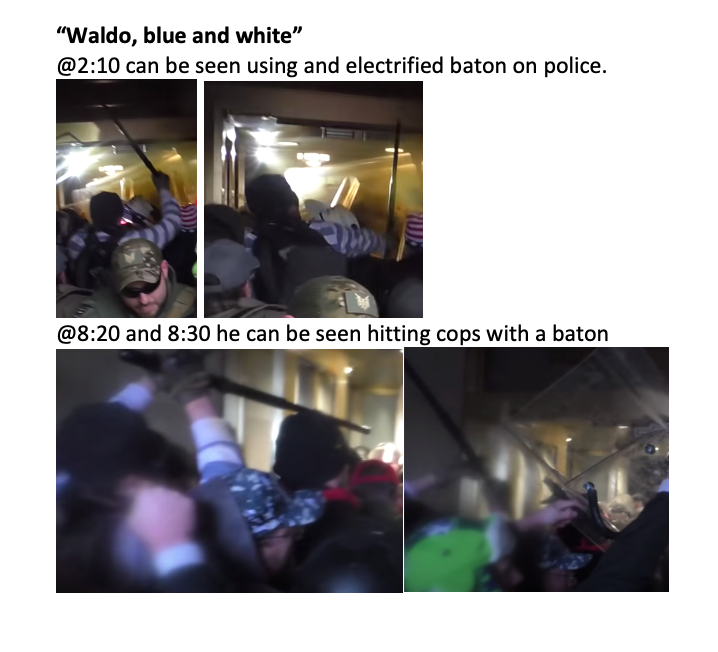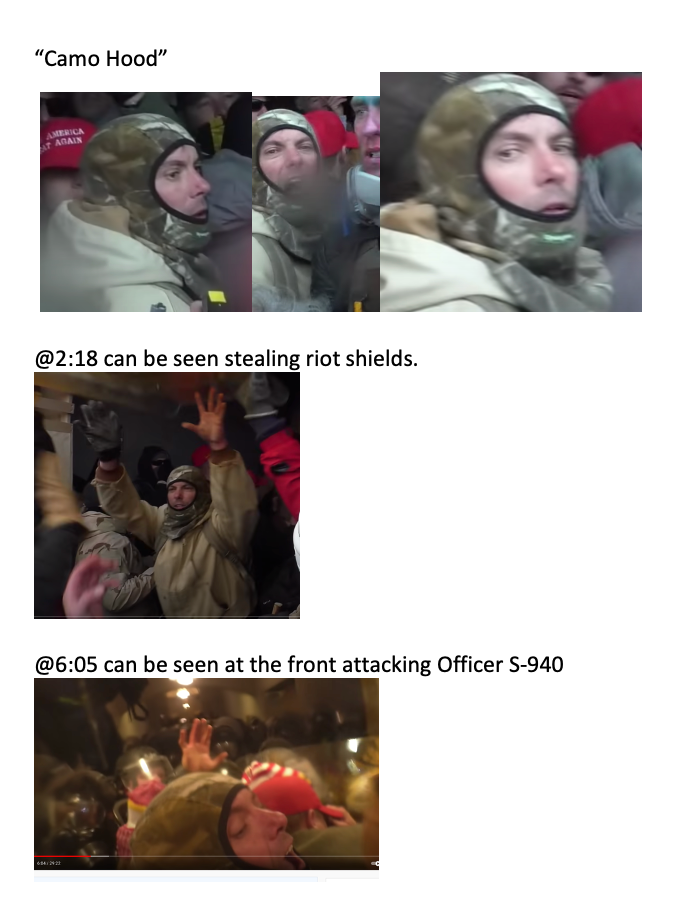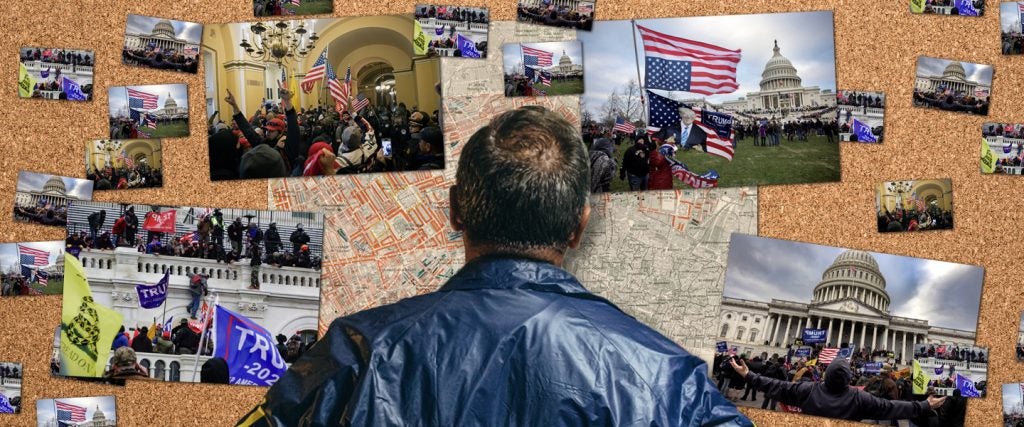As insurrectionists stormed the Capitol on January 6th of last year, most of us sat in horror, scrolling through photo after photo on Twitter or watching cable news in disbelief. But a select few civilians sprang into action, volunteering their time to help federal law enforcement piece together timelines and identify the perpetrators. Hundreds of arrests later, the FBI credits these online sleuths, now known as “sedition hunters,” for providing invaluable support in bringing those involved to justice. Below, one such sedition hunter, a videographer in his 30s who asked to be identified only by his Reddit username, Sherlock_at_Home, describes the painstakingly obsessive lengths he went to review every piece of footage from the insurrection he could find — and how he fastidiously filtered that information back the FBI.
* * * * *
Watching what happened on January 6th unfold left me feeling helpless, powerless and horrified. I did feel a rush of relief when the votes were finally certified in the middle of the night, but as I stayed up, sifting through hashtags and watching more videos, I couldn’t help but feel personally attacked. Have you ever looked at historical events and wondered, “How would I have dealt with that?” This was that historical event for me. Our country was attacked by Americans who violently went after our elected officials. And so, I went to work.
It was clear that this was going to be a colossal investigation, and I decided I had enough experience editing and working with video to be of some use chronicling what had happened. The very first thing I did was back up videos that showed individuals committing coordinated acts of violence.
I chose one long-form video of the West Tunnel brawl and decided to focus on that. Over the course of that first week, I got into a good workflow. My process was simple and straightforward: In order for law enforcement to secure warrants, I figured the evidence would need to be produced for a grand jury, so I decided to track individuals depicted in the long-form video, then break down every crime that individual committed. I’m a video editor by trade. Thus, combing through hundreds of hours of footage looking for obscure and minute details is a skill I’ve honed, and this felt more important than figuring out which wedding photo makes the bride look best.
In the beginning, I was most interested in the people who seemed to have some kind of leadership role. As time went on, though, I wrote reports on people who fit one of three criteria: 1) They committed documented acts of violence against police or media; 2) they acted to command or encourage other people to act violently; or 3) they captured enough media of themselves committing a crime (and of others committing a crime) that they needed to be turned in for evidentiary sake.
When I started doing this, there was no FBI Most Wanted list, just a form on the FBI website asking for any information available. So for each individual who met those criteria, I’d complete a full-page report with clean photos of their faces, screengrabs from the video of crimes they committed and timestamps of when those happened. Eventually, I’d cross-reference those crimes with depictions of the actions across other videos for good measure.
For example, during the second week after the attack, I focused on a two-hour, uncut video of a man who entered the Capitol. I mapped his movements, timestamped his video and built a model where I could jump to other videos taken in the Capitol at the same time to see other angles. I can’t quantify how many hours I’ve spent scouring Parlor, Snapchat, Twitter and YouTube to find all of these videos. I even downloaded the architectural maps of the three floors of the Capitol so I could orient them with the video I was dissecting and map the timing of people’s movement across the floor plan, then cross-compare unrelated videos I knew were shot in the same area.
When an assault on an officer occurred, I’d work to establish the officer’s name and badge number, as well as a timestamp so they could quickly find the footage on their own body cameras.
Once I tracked an individual through the entirety of the long-form video, cross-referenced those actions with other videos and documented everything I gathered, I’d submit it as an individual tip via the FBI online submission form. Then I’d start again on the next person. By January 15th, I’d submitted over 50 separate profiles to the FBI.
An online community eventually formed around what I was doing, but ultimately, I decided I worked best alone, like Golem in the cave talking to himself. That doesn’t mean I was isolated, though. The decentralized network of sedition hunters was always quick to share the best tricks. Not to mention, a few times I reached out on Reddit to post requests for help, information and updates. Within the communities I post in, there is great support and encouragement, but when a post did well enough to make the front page of Reddit, the trolls would follow. The first post I made, for instance, opened a door for five death threats to come my way.
After one good tip, my work was streamlined to the top, and I soon started hearing back from the Joint Terrorism Task Force (JTTF) about my reports. They told me that the way I approached this was different than most because I took the legwork off them by bookmarking specific info about individuals, giving them enough actionable info to open a case. The reports I submitted started being dealt with in one of two ways: If I discovered the person’s name and where they were from, I’d be pushed to a special agent in that person’s area. If I wasn’t able to identify someone, my report would go to the JTTF.

I’ve had over a dozen calls with members of the JTTF, the Capitol Police and a few special agents around the country, and they’ve all expressed what seemed like genuine gratitude for my efforts. Some have told me, “You’ve literally built the case for me and done my job,” saying that they just need to review my submission and type it up formally to secure an arrest warrant, which is wild. I was afraid at first that I was adding more noise to the whole thing, but the phone calls with those agents were incredibly motivating and encouraging.
Admittedly, I was a bit obsessed for a while, perhaps to an unhealthy degree. I’d sometimes spend 20 hours a day making profiles of violent offenders and writing reports. I know that sounds insane, but I was fueled by this underlying fear that these people would continue wreaking havoc if they weren’t stopped. I really felt like the bottom was falling out of the country.
Over time, though, I was struggling to sleep without it occupying my dreams. When I started seeing the bags under my eyes, it was time to step away and get some space. I have a saying I live by: “A drowning lifeguard is a second victim, not a savior.” I knew I needed to step back and let others take the baton for a bit. And so, I finished my last few profiles and did exactly that.

After 10 days off, I could feel my sense of self return, and by that time, the FBI had released hundreds of wanted posters, including at least a dozen folks I’d profiled, which made me feel more comfortable. It was clear that the authorities were allocating the resources necessary to this.
These days, I follow hundreds of Google Alerts, court filings and charging documents. I also keep a spreadsheet to track when major things are happening. Occasionally, I’ll pass along new information to specific agents handling individual cases as well.
I try to use my time now to talk about how to better discuss and conceptualize the events of January 6th. It’s important to clearly delineate the people present in D.C. that day. I don’t think it’s healthy or right to consider everyone who went to Trump’s rally to be a terrorist or seditionist. It devalues the reality of the situation. The vast majority of people in D.C. were doing nothing wrong, legally speaking. But a great many people did commit violent crimes in an attempt to “Stop the Steal.” Those were the people I was most interested in and concerned by.
In total, I submitted detailed profiles of over 130 individuals to the FBI. To date, at least 70 of them have been featured on the newly formed Violence at the Capitol Most Wanted list, 30 are facing more than 200 combined charges and three have pleaded guilty or been convicted.
I never did this out of disdain for President Trump or the Republican Party. I did this because the Capitol was attacked in an effort to end the American democratic process. I’ve never felt as un-American as I did that night afternoon listening to Lee Greenwood’s “Proud to Be American” play on repeat as people beat police officers with American flags. A year later, I feel exceptionally proud of my tiny contribution to our country and the greater democratic experiment.

